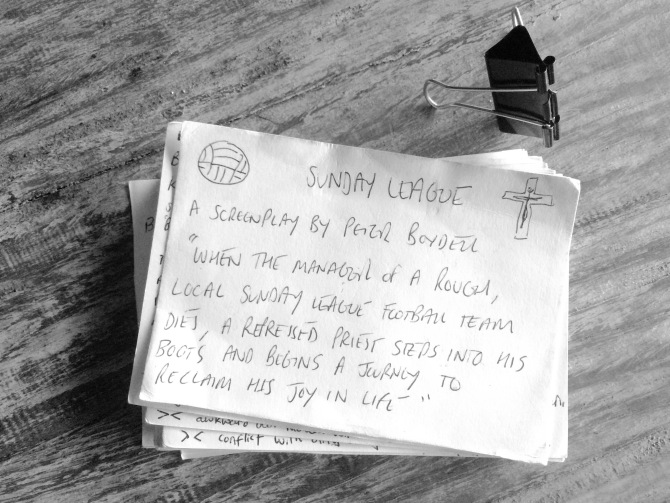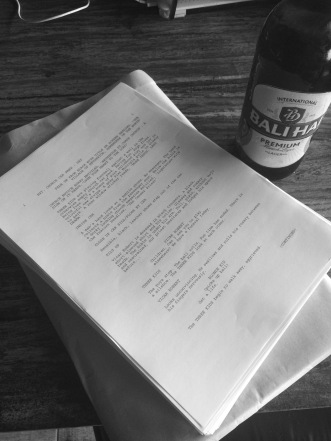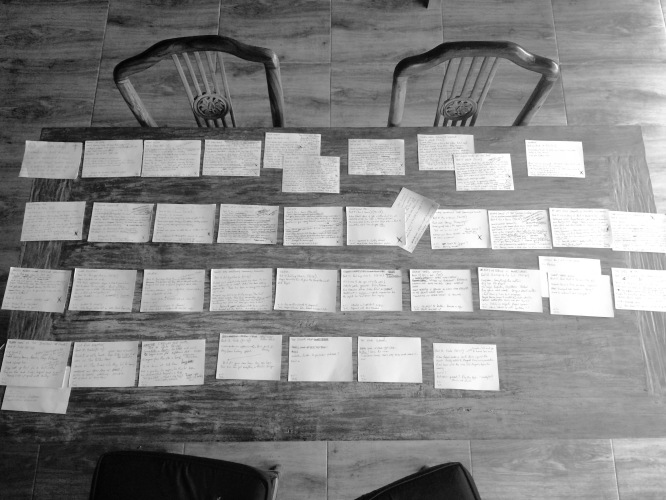When the manager of a rough, local, Sunday League football team dies, a repressed vicar steps into his boots and begins a journey to reclaim his joy in life.
Set in the imaginary story world of Netherton, Vicar Robert is a hunky but repressed, mid-30’s vicar in charge of Netherton St. Chad’s. Struggling with his back-story of loss, Vicar Robert delivers a boring funeral for Ronny, Manager of The Ship F.C. At the funeral he meets an old friend, Denny Pilchards. Denny and Vicar Robert played football together as kids but while Denny went on to play for Northford Albion and England, Robert met a girl and their paths split. Re-united, Denny is the catalyst for Vicar Robert to have one last foray into football and set a course to reclaim his joy in life. Through karaoke, finger-blasting, head-butts, strip clubs, lusty confessionals and the simulation of sex with a chicken, can Vicar Robert escape his shadow and defeat the tyranny of church administrator Margaret, Archdeacon Hadley and value-meats-empire-pervert Dirty Dougie Ferguson, to bring home the Netherton and Boundaries Cup for Ronny?
Up The Ship!
A copy of the script first draft can be downloaded on pdf at the bottom of this essay.
Billed as The Last Book On Screenwriting You’ll Ever Need, Blake Snyder’s, ‘Save The Cat’ details a screenwriting method, which can be applied as a template for a script. A recommendation from a friend in the industry put me onto the book and as closely as I can, I have followed the template and applied the teachings to understand the formula and create a script, Sunday League. The intention is not to create my masterpiece or some great work of fiction. The intention is simply to engage with Snyder’s argument, study some tactics, practice some laws and complete a script that will take my competence and confidence to the next level.
I read the book in Jibhi, Himachal Pradesh, Northern India in June in a little wooden hut high in the Himalayas. It’s funny. Snyder comes across as a bit boastful and single-minded at times and the formula is very much steered towards a Disney or Hollywood-style story, but we can forgive that as we have a very concise theory and a genuinely useful tool. There are tips on creating a logline, notes on genre, identification of fifteen ‘beats’ within a script and tips on creating an active hero who saves the cat. However, the main crux of the book is the practical method of working with forty cards to start crafting the plot to the prescribed beats. My forty cards have rarely left my side from Bangkok, through Thailand, Cambodia, Laos, Malaysia and Singapore. Now, I sit here on the balcony-desk in September with a stunning view of Gunung Agung, the largest volcano in Bali. I’m enjoying a turmeric tea with a completed first draft of my second screenplay. Thank you Mr Snyder.

Since Save The Cat, other books have been informing the screenwriting process for me. John Truby has a far more detailed approach to the process in ‘The Anatomy of Story’. Whilst Save The Cat suggests starting with a good concept or logline, The Anatomy of Story encourages a different start point: the final revelation. Looking back on the failings of my screenplays to date, including Sunday League, I agree with Truby.
Truby argues that starting with an ultimate query of morality for the hero, towards the end of the story, and working backwards from there, is better. From that end point, we design a desire line for each major character. This informs their actions towards a goal. We apply a theme (morality) line for each major character, which puts them in conflict with the hero, and potentially, each other. We construct a symbol and motif web and we include a far more detailed analysis and staged-development of hero, opponents, allies and their respective revelations. Truby also encourages adding more ‘reveals’ throughout the story which takes Truby to twenty-two beats against Snyder’s fifteen.
So, Truby encourages a finer craft, although Snyder offers a simpler and less intimidating template. Both have their benefit. When it comes to the writing stage however, The 10 Day Screenplay by Darrin Donnelly is a fiery, motivational essay, which gets you splurting the words out without fear. Three books there. Very different. All of value.
Where does this screenplay fail?
Obviously there’s more than this but here are my big three for starters:
1. I am suffering from a slightly inactive hero. For a future edit I will try and get him taking the lead and taking control more of certain situations and scenes. However, I do understand that if a character is exhibiting repression, then this may be harder than it would be for another, more ballsy lead character.
2. Vicar Robert is not as interesting as I’d like. I toyed with the idea of him getting angrier at times and maybe for future edits he will. This is ultimately a problem of not doing enough character ground-work for Vicar Robert at the early concept stage. As I was working to the, ‘Save The Cat’ formula for this, I started with a concept, a logline, and the story was constructed from there. Ultimately, I agree with Truby that a better start point is a moral query and a final revelation. This ensures that you do all the necessary character work up front and you’re not trying to cram a character into a story network that already exists and is then difficult to unpick.
3. I’d like to have investigated the Dougie character more. There’s the start of a good character but he was actually more of an after-thought. Again, this stresses the importance of starting with hero and opponent final revelations and going backwards from there. I’d like to have seen Dougie have a proper revelation himself.
4. I’ve included shots. I shouldn’t have. This is inexperience on my part. Many of the screenplays I have read include shots. I realise now that there is a difference between a shot screenplay (for later down the line by the director) and a spec screenplay (a more basic premise). The shots interrupt the flow of the story. If you’re reading this first draft, please be forgiving. I’m sorry for the inconvenience.
5. My non-dialogue descriptions are cold and instructional. I have not focused on creating a nice flow of creative writing. I will fix this for the next edit.
Where does this screenplay win?
As much as the screenplay loses, it wins, here’s why:
1. Milky is a nice C-Story. One of the less competent members of the team has his own little character arc, which adds depth and pulls a heart-string.
2. Linda is great. Loosely based on my own sister, she is loud, direct, pragmatic and shit on karaoke. Ronny might be dead, but Linda certainly isn’t.
3. Denny Pilchards, our catalyst, was in danger of stealing the show early on and making Vicar Robert look even more boring. But to have him coming back into the story later in a different way adds fun to the ending, without stealing the show from Vicar Robert.
Here’s a copy of the first draft as a pdf below, which you are of course very welcome to read. On one condition! I get some feedback. Thank you so much for your attention and help.
Script Sunday League First Draft 150917
Further reading:
An excerpt from, ‘The Local’, a screenplay by Peter Boydell, here.
Thank you for reading. And yes, we’re off to the beach tomorrow.
Enjoy.
Pete


 Share this:
Share this:




